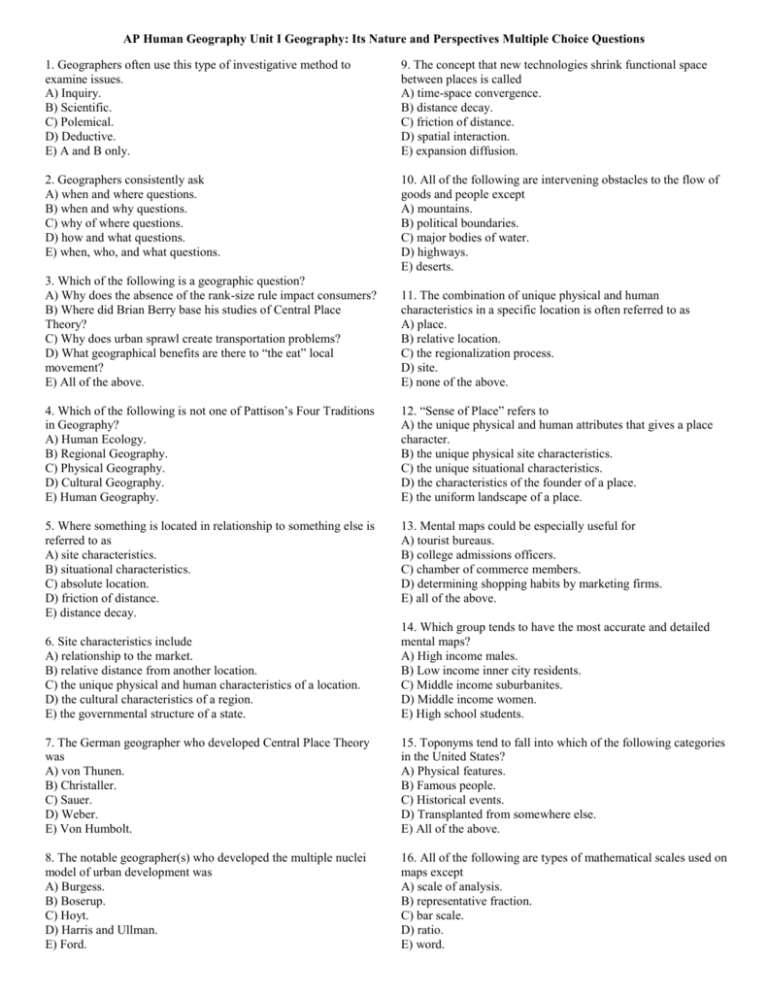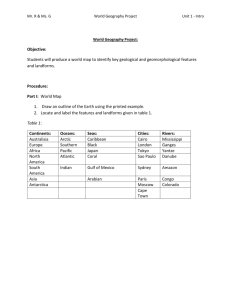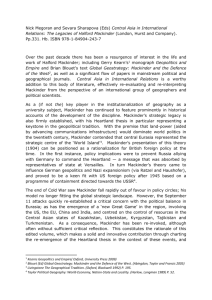Unit 1 MCQs - Henry County Schools
advertisement

AP Human Geography Unit I Geography: Its Nature and Perspectives Multiple Choice Questions 1. Geographers often use this type of investigative method to examine issues. A) Inquiry. B) Scientific. C) Polemical. D) Deductive. E) A and B only. 9. The concept that new technologies shrink functional space between places is called A) time-space convergence. B) distance decay. C) friction of distance. D) spatial interaction. E) expansion diffusion. 2. Geographers consistently ask A) when and where questions. B) when and why questions. C) why of where questions. D) how and what questions. E) when, who, and what questions. 10. All of the following are intervening obstacles to the flow of goods and people except A) mountains. B) political boundaries. C) major bodies of water. D) highways. E) deserts. 3. Which of the following is a geographic question? A) Why does the absence of the rank-size rule impact consumers? B) Where did Brian Berry base his studies of Central Place Theory? C) Why does urban sprawl create transportation problems? D) What geographical benefits are there to “the eat” local movement? E) All of the above. 11. The combination of unique physical and human characteristics in a specific location is often referred to as A) place. B) relative location. C) the regionalization process. D) site. E) none of the above. 4. Which of the following is not one of Pattison’s Four Traditions in Geography? A) Human Ecology. B) Regional Geography. C) Physical Geography. D) Cultural Geography. E) Human Geography. 12. “Sense of Place” refers to A) the unique physical and human attributes that gives a place character. B) the unique physical site characteristics. C) the unique situational characteristics. D) the characteristics of the founder of a place. E) the uniform landscape of a place. 5. Where something is located in relationship to something else is referred to as A) site characteristics. B) situational characteristics. C) absolute location. D) friction of distance. E) distance decay. 13. Mental maps could be especially useful for A) tourist bureaus. B) college admissions officers. C) chamber of commerce members. D) determining shopping habits by marketing firms. E) all of the above. 6. Site characteristics include A) relationship to the market. B) relative distance from another location. C) the unique physical and human characteristics of a location. D) the cultural characteristics of a region. E) the governmental structure of a state. 14. Which group tends to have the most accurate and detailed mental maps? A) High income males. B) Low income inner city residents. C) Middle income suburbanites. D) Middle income women. E) High school students. 7. The German geographer who developed Central Place Theory was A) von Thunen. B) Christaller. C) Sauer. D) Weber. E) Von Humbolt. 15. Toponyms tend to fall into which of the following categories in the United States? A) Physical features. B) Famous people. C) Historical events. D) Transplanted from somewhere else. E) All of the above. 8. The notable geographer(s) who developed the multiple nuclei model of urban development was A) Burgess. B) Boserup. C) Hoyt. D) Harris and Ullman. E) Ford. 16. All of the following are types of mathematical scales used on maps except A) scale of analysis. B) representative fraction. C) bar scale. D) ratio. E) word. 17. How an issue changes with respect to whether it is looked at from a local to global perspective is referred to as A) cultural ecology. B) map scale. C) scale of analysis. D) perspective. E) dimensionality. 18. The population distribution of the United States most closely resembles A) a linear pattern. B) a dispersed pattern. C) a geometric pattern. D) a clustered pattern. E) a clustered and dispersed pattern. 19. This geographer who developed the multiple hearth theory with respect to agriculture was A) Ether Boserup. B) Thomas Malthus. C) Henrich von Thunen. D) Carl Sauer. E) Max Weber. 25. The concept that wealth is concentrated in the core and as one move towards the periphery the level of wealth declines was developed by A) Mackinder. B) Wollerstein. C) Ravenstein. D) Rubenstein. E) Christaller. 26. Mackinder’s heartland theory states that in order to dominate the world a power must control A) the Eurasian core. B) Western Europe. C) the British Isles. D) the coasts of major continents. E) the Americas. 27. Rostow’s model of development includes fives stages which include all of the following except A) the traditional society. B) preconditions for takeoff. C) age of mass consumption. D) age of post industrial growth. E) take off. 20. This northern German landowner put forth his ideas in an essay titled The Isolated State. A) Alexander Von Humbolt. B) Max Weber. C) Henrich Von Thunen. D) Barron Stueben. E) Otto Bismark. 28. Weber’s least cost theory deals with A) location of services. B) industrial location. C) location of agricultural hearths. D) location of wealth. E) location of political power. 21. The nesting of services in settlements of various sizes is typical of A) Central Place Theory. B) Multiple Hearths Theory. C) Transition Theory. D) Least Cost Theory. E) the Rimland Theory. 29. Burgess developed the first urban land use model which depicts land use in A) concentric rings. B) nodes of activity. C) sectors of land uses. D) multiple nuclei. E) fragmented clusters. 22. The migration transition theory put forth by Zelinsky is based upon the A) Demographic Transition Model. B) Ravenstein’s 11 laws of migration. C) Weber’s least cost theory. D) Rostow’s development theory. E) Mackinder’s heartland theory. 30. All of the following developed urban land use models except A) Hoyt. B) Burgess. C) Christaller. D) Harris. E) Ulman. 23. ___________ developed his 11 laws of migration in 1885. A) Malthus B) Weber C) Wollerstein D) Ravenstein E) Rubenstein 24. Malthus’ basic thesis was that population grows exponentially while food production grows A) constantly. B) geographically. C) arithmetically. D) geometrically. E) out of control. 31. Many barrier islands on the east coast of the United States are examples of what pattern of development? A) Linear. B) Clustered. C) Dispersed. D) Geometric. E) No pattern exists. 32. The Township and Range pattern of land division in the United States created this type of land ownership pattern on the landscape? A) Linear. B) Clustered. C) Dispersed. D) Geometric. E) No pattern exists. 33. The Township and Range land division method helped to create what type of rural settlement pattern? A) Linear. B) Clustered. C) Dispersed. D) Geometric. E) No pattern exists. 34. Which of the following is not a key element on a map? A) Legend. B) Scale. C) Meta data. D) Title. E) Source. 35. All maps have A) distortion. B) graduated circles. C) representative fractions. D) bar scale. E) multiple colors. 36. Which map projection is most distorted at high latitudes? A) Robinson. B) Goode’s. C) Equal area value. D) Conic. E) Mercator. 37. The type of map that shows areas with statistical values in three to five categories is known as a A) dot distribution map. B) choropleth map. C) graduated circle map. D) Robinson map. E) none of the above. 38. The idea that spatial interaction declines as distance increases is known as A) time-space compression B) the gravity model. C) migration transition. D) distance-decay. E) network integration. 39. The relative attractiveness or value for a piece of property is related to its A) accessibility. B) sense of place. C) time compression factor. D) gravity model. E) situational characteristics. 40. Transportation improvements have impacted geographical concepts such as A) friction of distance. B) functional distance. C) globalization. D) time space compression. E) all of the above. 41. GPS stands for A) geographic place synthesis. B) global peoples standards. C) geographic positioning science. D) global positioning system. E) geographic polarity system. 42. GPS devices determine A) x, y, and z values for an object. B) longitude and latitude. C) relative location within 100 yards. D) altitude. E) time distance-decay. 43. Remote Sensing is often used during peace-time to analyze A) urban sprawl. B) spread of desertification. C) loss of prime agricultural land. D) irrigation needs for farmers. E) all of the above. 44. Geographic Information Systems uses multiple layers of information to produce A) computer maps. B) infrared satellite images. C) aerial photographs. D) oblique images. E) hand drawn maps. 45. Aerial photography was first widely used in A) the Civil War. B) the Franco Prussian War. C) World War I. D) World War II. E) the Korean War. 46. The U.S. Constitution stipulates that a census of the population must be taken every A) year. B) 2 years. C) 5 years. D) 10 years. E) 12 years 47. Methods of collecting data in the field include A) observations. B) interviews. C) scientific data collection. D) census workers. E) all of the above. 48. In order to analyze patterns on the landscape geographers often start with A) observations. B) collecting data in a lab. C) interviews. D) internet data searches. E) none of the above. 49. The American geographer who developed a school of cultural geography focused on the cultural landscape was A) Walter Christaller. B) Max Weber. C) Carl Sauer. D) Alexander Von Humbolt. E) Marvin Hall. 50. The process by which technology is increasing the connectivity and interdependence of the world’s business community is often referred to as A) interaction. B) integration. C) democratization. D) globalization. E) all of the above. Unit 1 Answer Sheet 1. 2. 3. 4. 5. 6. 7. 8. 9. 10. 11. 12. 13. 14. 15. 16. 17. 18. 19. 20. 21. 22. 23. 24. 25. 26. 27. 28. 29. 30. 31. 32. 33. 34. 35. 36. 37. 38. 39. 40. 41. 42. 43. 44. 45. 46. 47. 48. 49. 50. ________ ________ ________ ________ ________ ________ ________ ________ ________ ________ ________ ________ ________ ________ ________ ________ ________ ________ ________ ________ ________ ________ ________ ________ ________ ________ ________ ________ ________ ________ ________ ________ ________ ________ ________ ________ ________ ________ ________ ________ ________ ________ ________ ________ ________ ________ ________ ________ ________ ________









